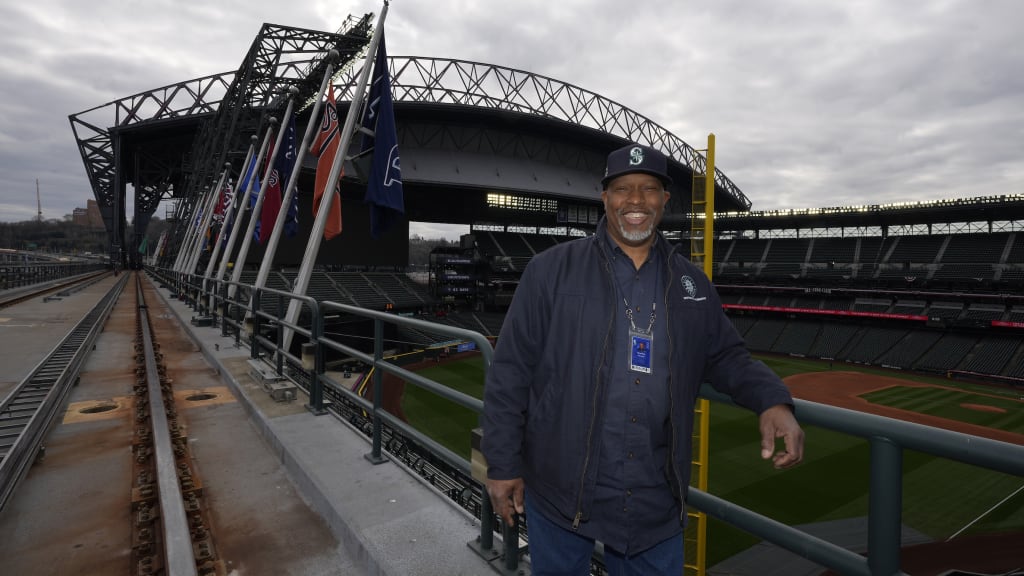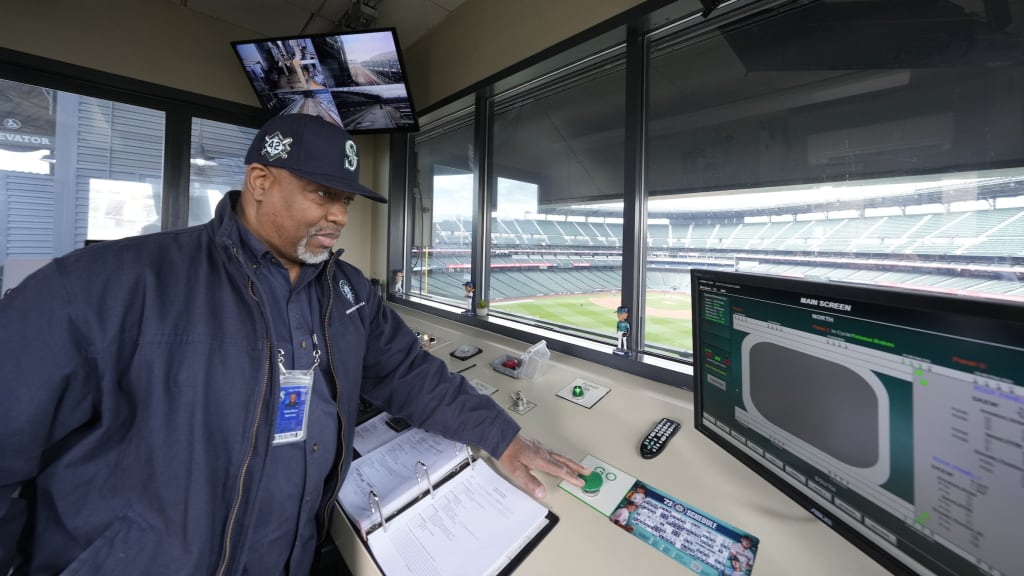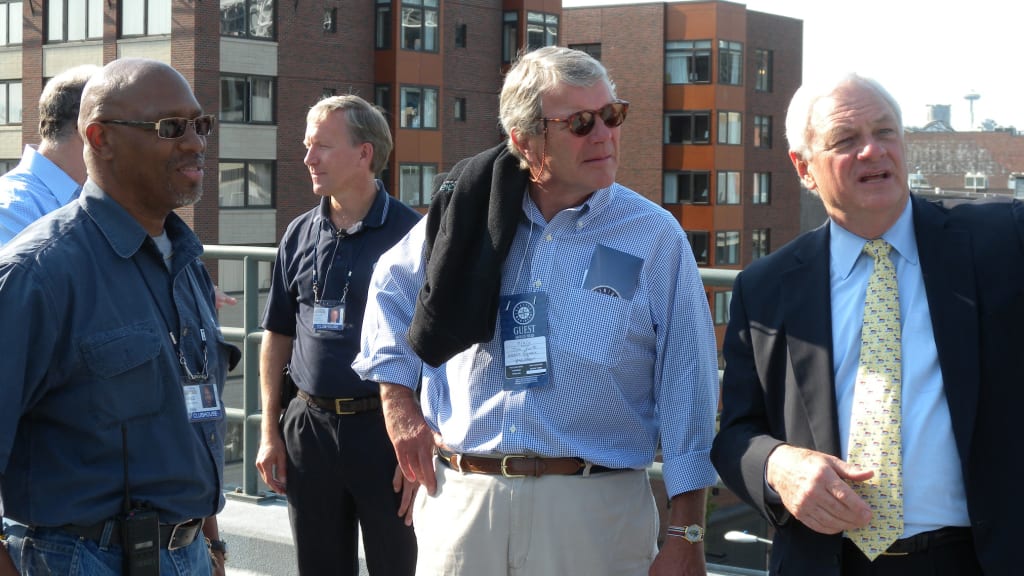
SEATTLE -- It can be said that the crown jewel of T-Mobile Park is its retractable roof. Its “umbrella” design was the first of its kind when the ballpark opened almost 24 years ago, and since then, there’s only been one person responsible for leading its operation -- Vance Akres.
There isn’t anything about the roof that Akres doesn’t know. Not only has he been on the lead controls since 1999 -- he helped build it.
Akres spent the first 22 years of his career as a journeyman iron worker and was on the construction crew that built the ballpark. He helped put the roof’s transport system together, assembling the equipment and components, but he never dreamed it would be his last job in construction. Once the ballpark was complete, he planned to move onto other projects at then-CenturyLink Field and the Tacoma Narrows Bridge.
But everything changed when Ben Barton, the Mariners' director of engineering & maintenance at the time, approached Akres with the offer to join the organization in 1999 and supervise the roof’s operation when then-Safeco Field opened.
“At the time, there was a lot going through my head,” recalls Akres. “Should I stay with my trade union or change my career? It was a good time for me to make a change, because the ironworking trade is really demanding on your body, it’s a dangerous job. I knew it was a challenge because of the roof, but I decided to go forward and change my career.”
Akres has been at the controls ever since. When he started, he also wore many hats on the engineering team.
“I was the roof operator, the shipping and receiving guy, general maintenance, HVAC technician … I wore all hats helping everyone before we started branching out and getting more people here,” Akres said.

And when it came to leading the roof operation, it was a 24/7 job especially in those early days of learning the ins and outs of the new ballpark. The job remains stressful today, just given the nature of the game’s dependency on the roof’s successful operation. Akres now has a two-person crew to support him in the roof control booth nestled high above center field, but that pressure is what keeps him in the role.
“I like the challenge of it, of keeping it working,” he said. “I know it’s stressful, but I like being the guy who doesn’t have a rainout. I haven’t had a rainout since I’ve been supervisor of it. We had a close one in 2000, when we had a rain delay for 55 minutes, but other than that we haven’t had any.”

In addition to its general operation, Akres is responsible for preventative maintenance of the roof, as well as being able to troubleshoot issues as they happen in real time -- sometimes right before first pitch or during the middle of a game. But that is when Akres is at his best.
“I think out of the box a lot,” he said. “I think that is part of my trade-union skills. In the ironworker trade, if something doesn’t work, we have to improvise and make it work, especially in construction. I think about the same principle here at the ballpark. If it doesn’t work, I think of another way to make it work and make it safe.”
Akres was inspired to pursue a career in construction when he was a teenager growing up in Portland, Ore. At age 16, he worked for the U.S. Army Corp of Engineers, dredging the channel where the Columbia River and Pacific Ocean met. For an entire summer, Akres lived and worked on the dredge ship for 10 days at a time (with four days off in between), building sand dunes underneath the ocean.
“That got me into the construction industry,” he recalls.
Three years later, he moved to Seattle and started his career as a journeyman iron worker. He loved his time in the construction industry, and through his various jobs over those years, he helped to build the city’s infrastructure.
“It was an interesting job, I worked all over the Puget Sound area,” he said. “I put up the container cranes, the high rises, all the overpasses. I worked on Bill and Melinda Gates’ home and the first Microsoft campus.”
Now when Akres monitors the roof track’s runways, he looks out at the city skyline he built -- from the ballpark he built.

Two of Akres’ most valuable partnerships within the organization are with the grounds crew and ballpark operations leadership. The grounds crew monitors the weather and is in constant contact with him about whether to retract or extend the roof. He is also in consistent contact with senior vice president of ballpark operations Trevor Gooby to keep him informed about any issues or updates.
“I lean on Vance for his knowledge and experience,” Gooby said. “He also has a very calming manner to him that allows him to deal with very difficult situations. He has made a huge impact on T-Mobile Park and the Mariners, and I appreciate his dedication to our club.”
Akres recalls that during Chuck Armstrong’s tenure as president, Armstrong had the grounds crew practice rolling out the tarp because they rarely did so. And on one of those occasions, then-head groundskeeper Bob Christofferson wanted the engineers to help -- Akres included.
“After that, I said I’m making sure this roof is working at all times,” he laughed.
Over the course of his career, Akres has seen many changes -- in the ballpark and across the organization. But everything has changed for the better he says. And with those changes, comes a new role for him -- mentor.
“The younger generation is coming in now,” he said. “I’ve got to mentor them and give them my knowledge. They come to me quite a bit, and I give them all the information that I do know.”
Akres says he’s just a few years away from retirement, and when he looks back on his career, he does so with pride.
“I love working for the Mariners organization. Other ballparks have tried to recruit me, but I said, ‘No, I’m staying with the Mariners.’ I love this organization. I wouldn’t trade it for the world.”

